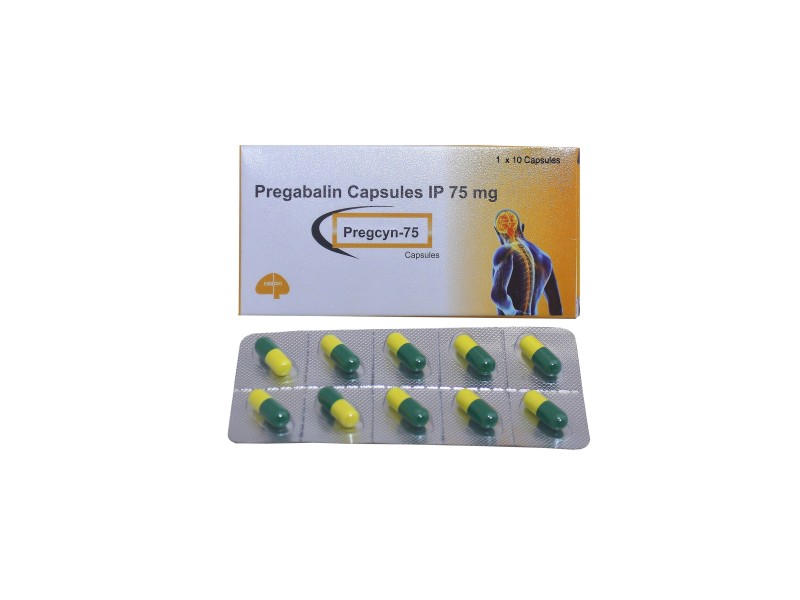Pregabalin -75
Pregabalin-75mg
Pregabalin is a prescription medication used to treat pain from damaged nerves caused by diabetes, shingles, and spinal cord injury. It is also used to treat fibromyalgia and seizures. Pregabalin belongs to a class of drugs called anticonvulsants, which may work by decreasing pain signals from the brain and slowing brain activity.
This medication comes in capsule form and liquid form and is usually taken 2 or 3 times daily, with or without food.
Common side effects include dizziness, blurred vision, weight gain, and drowsiness. Do not drive a car or operate heavy machinery until you know how pregabalin affects you.

Mechanism of action:
- Pregabalin blocks the VGCC (voltage-gated calcium channels) and hence decrease glutamate and sensory neuropeptides (substance P and CGRP) release at synapse by decreasing Ca2+ influx.
Pharmacokinetic:
- Absorption: Pregabalin is absorbed from the intestines by an active transport process mediated via the large neutral amino acid transporter 1 (LAT1, SLC7A5), a transporter for amino acids such as L-leucine and L-phenylalanine. Very few (less than 10 drugs) are known to be transported by this transporter. Unlike gabapentin, which is transported solely by the LAT1, pregabalin seems to be transported not only by the LAT1 but also by other carriers. The LAT1 is easily saturable, so the pharmacokinetics of gabapentin are dose-dependent, with diminished bioavailability and delayed peak levels at higher doses. In contrast, this is not the case for pregabalin, which shows linear pharmacokinetics and no saturation of absorption.The oral bioavailability of pregabalin is greater than or equal to 90% across and beyond its entire clinical dose range (75 to 900 mg/day). Food does not significantly influence the oral bioavailability of pregabalin. Pregabalin is rapidly absorbed when administered on an empty stomach, with a Tmax (time to peak levels) of generally less than or equal to 1 hour at doses of 300 mg or less. However, food has been found to substantially delay the absorption of pregabalin and to significantly reduce peak levels without affecting the bioavailability of the drug; Tmax values for pregabalin of 0.6 hours in a fasted state and 3.2 hours in a fed state, and the Cmax is reduced by 25–31% in a fed versus fasted state.
- Distribution: Pregabalin crosses the blood–brain barrier and enters the central nervous system. However, due to its low lipophilicity, pregabalin requires active transport across the blood–brain barrier. The LAT1 is highly expressed at the blood–brain barrier and transports pregabalin across into the brain. Pregabalin has been shown to cross the placenta in rats and is present in the milk of lactating rats. In humans, the volume of distribution of an orally administered dose of pregabalin is approximately 0.56 L/kg. Pregabalin is not significantly bound to plasma proteins (<1%).
- Metabolism: Pregabalin undergoes little or no metabolism. In experiments using nuclear medicine techniques, it was revealed that approximately 98% of the radioactivity recovered in the urine was unchanged pregabalin. The main metabolite is N-methylpregabalin.
- Elimination: Pregabalin is eliminated by the kidneys in the urine, mainly in its unchanged form. It has a relatively short elimination half-life, with a reported value of 6.3 hours. Because of its short elimination half-life, pregabalin is administered 2 to 3 times per day to maintain therapeutic levels. The kidney clearance of pregabalin is 73 mL/minute.
Pharmacodynamic:
- Pregabalin is a gabapentin and acts by inhibiting certain calcium channels. Specifically it is a ligand of the auxiliary α2δ subunit site of certain voltage-dependent calcium channels (VDCCs), and thereby acts as an inhibitor of α2δ subunit-containing VDCCs. There are two drug-binding α2δ subunits, α2δ-1 and α2δ-2, and pregabalin shows similar affinity for these two sites. Pregabalin is selective in its binding to the α2δ VDCC subunit. Despite the fact that pregabalin is a GABA analogue, it does not bind to the GABA receptors, does not convert into GABA or another GABA receptor agonist in vivo, and does not directly modulate GABA transport or metabolism. However, pregabalin has been found to produce a dose-dependent increase in the brain expression of L-glutamic acid decarboxylase (GAD), the enzyme responsible for synthesizing GABA, and hence may have some indirect GABAergic effects by increasing GABA levels in the brain.
- There is currently no evidence that the effects of pregabalin are mediated by any mechanism other than inhibition of α2δ-containing VDCCs. In accordance, inhibition of α2δ-1-containing VDCCs by pregabalin appears to be responsible for its anticonvulsant, analgesic, and anxiolytic effects.Pregabalin was found to possess 6-fold higher affinity than gabapentin for α2δ subunit-containing VDCCs in one study. However, another study found that pregabalin and gabapentin had similar affinities for the human recombinant α2δ-1 subunit. In any case, pregabalin is 2 to 4 times more potent than gabapentin as an analgesic and, in animals, appears to be 3 to 10 times more potent than gabapentin as an anticonvulsant.
Precautions:
- This medicine may cause serious allergic reactions, including angioedema, which can be life-threatening and require immediate medical attention.The use of alcohol or other medicines that affect the CNS with pregabalin may worsen the side effects of this medicine, such as dizziness, poor concentration, drowsiness, unusual dreams, and trouble with sleeping.It may also cause some people to have suicidal thoughts or to become more depressed.This medicine may cause respiratory depression, a serious breathing problem that can be life-threatening, when used together with narcotic pain medicines.
- Do not drive or do anything else that could be dangerous until you know how this medicine affects you.
- This medicine may increase your or your child’s risk for cancer (hemangiosarcoma) and bleeding.
- Do not suddenly stop taking pregabalin without checking first with your doctor. Stopping the medicine suddenly may cause seizures or side effects such as dizziness, diarrhoea, nausea, headaches, vomiting, irritability, trouble with sleeping, nightmares, or tingling feelings.
- Do not take other medicines unless they have been discussed with your doctor.
Side effects:
- Commonly reported side effects of pregabalin include: infection, ataxia, blurred vision, constipationC, diplopia, dizziness, drowsiness, fatigue, headache, peripheral edema, tremor, weight gain, visual field loss, accidental injury, and xerostomia.
Dosage:
- Take pregabalin exactly as prescribed by your doctor. The recommended dosage varies depending upon the patient’s kidney function (creatinine clearance) and the medical condition being treated.
- The recommended starting dose is 150 mg per day in divided doses. The maximum dose is 300 mg per day, 450 mg per day or 600 mg per day, depending on the condition being treated.
Over dosage:
- If you take too much pregabalin (more than the prescribed amount), call your local Poison Control Center or seek emergency medical attention right away.
Warning:
- Allergic reaction warning: This drug can cause serious allergic reactions. These include trouble breathing, shortness of breath, and rash, hives, and blisters on your skin. If you have any of these symptoms, stop taking this drug and seek medical help right away.
- Angioedema warning: This drug may cause angioedema, which is severe, sudden swelling under your skin. It may affect your arms, face, lips, tongue, or voice box.
- Suicidal thinking and behaviour warning: This drug can increase your risk of having suicidal thoughts and behaviour.
- Dizziness and drowsiness warning: This drug can cause dizziness, drowsiness, and blurry vision. It may affect your ability to think, see, or move. You shouldn’t drive, use machinery, or do other tasks that require alertness until you know how this drug affects you.
- Misuse warning: Use of this drug can lead to misuse. Your risk may be greater if you have a history of drug misuse.
- Respiratory depression (slow or shallow breathing) warning: This drug can cause respiratory depression. The risk of death is higher for people who take pregabalin with certain drugs, such as opioids, and people with lung or breathing problems.
Duration of action:
- Pregabalin is eliminated renally in the urine, mainly in its unchanged form. It has a relatively short elimination half-life, with a reported value of 6.3 hours. Because of its short elimination half-life, pregabalin is administered 2 to 3 times per day to maintain therapeutic levels.
Drug- drug interactions:
- Pregabalin oral capsule can interact with other medications, vitamins, or herbs you may be taking.Diabetes drugs, such as rosiglitazone and pioglitazone. Taking these drugs with pregabalin may cause weight gain or swelling of your hands or feet. If you have heart problems, taking these drugs together can increase your risk of heart failure.Opioid pain drugs, such as oxycodone. Taking these drugs with pregabalin may cause dizziness, sleepiness, and breathing problems. In some cases, it can cause death.
- Tranquilizers (drugs that make you sleepy) or drugs for anxiety, such as lorazepam. Taking these drugs with pregabalin may cause dizziness, sleepiness, and breathing problems. In some cases, it can cause death.
- Blood pressure drugs, such as captopril, enalapril, or lisinopril. Taking these drugs with pregabalin may cause swelling and hives.
Adverse reactions:
- Exposure to pregabalin is associated with weight gain, sleepiness and fatigue, dizziness, vertigo, leg swelling, disturbed vision, loss of coordination, and euphoria. It has an adverse effect profile similar to other central nervous system depressant
- The FDA determined that the substance dependence profile of pregabalin, as measured by a personal physical withdrawal checklist, was quantitatively less than benzodiazepines. Even people who have discontinued short term use of pregabalin have experienced withdrawal symptoms, including insomnia, headache, nausea, anxiety, diarrhoea, flu like symptoms, nervousness, major depression, pain, convulsions, hyperhidrosis and dizziness
Pregnancy:
- It is unclear if it is safe for use in pregnancy with some studies showing potential harm.Tell your doctor if you are pregnant or plan to become pregnant.
Fertility:
- Treatment with 600 mg/day pregabalin for 12 weeks does not adversely affect spermatogenesis or serum levels of FSH and testosterone in healthy males.
Contraindications:
- Hypersensitivity reactions have occurred in patients receiving pregabalin, including angioedema.Pregabalin has been detected in the milk of lactating women; thus, breastfeeding is not advisable, and an alternative agent is preferred.
Storage:
- This medicinal product does not require any special storage conditions. Store at room temperature away from light and moisture. Do not store in the bathroom. Keep all medications away from children and pets.
Breastfeeding:
- Tell your doctor if you are breastfeeding or planning to breastfeed. It is not known the pregabalin is excreted in human breast milk or it will harm your nursing baby.
